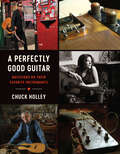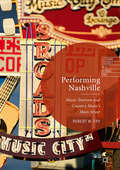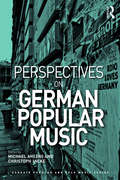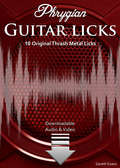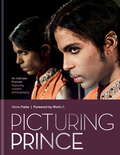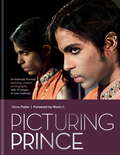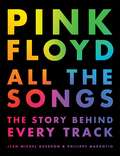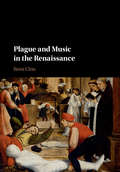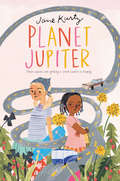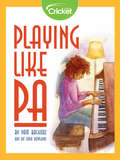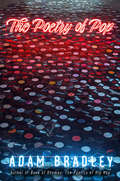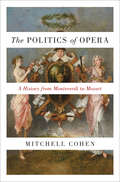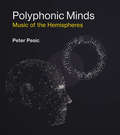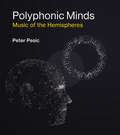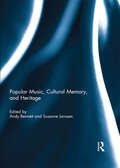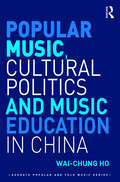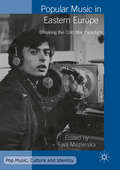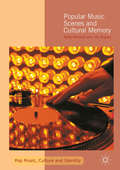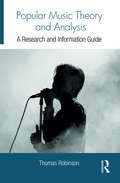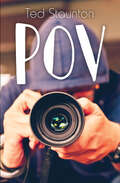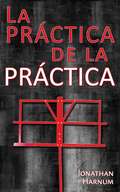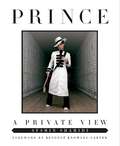- Table View
- List View
A Perfectly Good Guitar: Musicians on Their Favorite Instruments
by Chuck HolleyAsk guitar players about their instruments, and you&’re likely to get a story—where the guitar came from, or what makes it unique, or why the player will never part with it. Most guitarists have strong feelings about their primary tool, and some are downright passionate about their axes. Chuck Holley is a professional photographer and writer who loves music and listening to musicians talk about their trade. For several years, he has been photographing guitarists with their prized instruments and collecting their stories. This beautifully illustrated book presents these stories in revelatory photographs and words. The guitarists included in this book range from high-profile performers, including Rosanne Cash, Guy Clark, Laurence Juber, Jorma Kaukonen, JD Souther, Bill Frisell, Dave Alvin, and Kelly Willis, to renowned studio musicians and band members. Holley&’s beautifully composed photographs portray them with their favorite guitar, including detail shots of the instrument. Accompanying the photographs are the musicians&’ stories about the Gibsons, Fenders, Martins, and others that have become the guitar in their lives, the one that has a special lineage or intangible qualities of sustain, tone, clarity, and comfort that make it irreplaceable. Several musicians talk about how the guitar chose them, while others recount stories of guitars lost or stolen and then serendipitously recovered. Together, these photographs and stories underscore the great pleasure of performing with an instrument that&’s become a trusted friend with a personality all its own.
Performing Nashville
by Robert W. FryThis book explores the formation and continuance of Nashville, Tennessee as a music place, the importance of the fans (tourists) in creating Nashville's multifaceted musical identity, and the music and city's influence on the formation and performance of the individual and collective identities of the country-music fan. More importantly, the author discusses the larger issue of country music as a signifier of tradition suggesting that for many visitors, the music serves as a soundtrack, while Nashville serves as a performative space that permits the creation, performance, and remembrance of not only the country-music tradition, but also various individual and collective traditions and an idealized American identity. Through the theatrics of tourism, Nashville and its connection to country music are performed daily, reinforced through the sound and landscape of country music. Performing Nashville will be of interest to students and scholars across a range of disciplines, including tourism studies, leisure studies, ethnomusicology, sociology, folklore and anthropology.
Perspectives on German Popular Music (Ashgate Popular and Folk Music Series)
by Michael Ahlers Christoph JackeIn this book, native popular musicologists focus on their own popular music cultures from Germany, Austria and Switzerland for the first time: from subcultural to mainstream phenomena; from the 1950s to contemporary acts. Starting with an introduction and two chapters on the histories of German popular music and its study, the volume then concentrates on focused, detailed and yet concise close readings from different perspectives (including particular historical East and West German perspectives), mostly focusing on the music and its protagonists. Moreover, these analyses deal with very original specific genres such as Schlager and Krautrock as well as transcultural genres such as Punk or Hip Hop. There are additional chapters on characteristically German developments within music media, journalism and the music industry. The book will contribute to a better understanding of German, Austrian and Swiss popular music, and will interconnect international and especially Anglo-American studies with German approaches. The book, as a consequence, will show close connections between global and local popular music cultures and diverse traditions of study.
Phrygian Guitar Licks: 10 Original Thrash Metal Licks with Audio & Video (Modal Guitar Licks #3)
by Gareth Evans10 original thrash metal guitar licks from the Phrygian mode in tablature and notation for the progressing guitarist at intermediate level and above. >> 64 bars of music over 10 licks (average lick length 6.4 bars) >> Video at full speed & Audio at full & half speed (Downloadable) >> Backing tracks at full and slower practise speeds (Downloadable) >> Scale diagrams with theory and technique tips for each lick >> Guitar tablature has picking directions & fretting finger guide numbers Please Note: This eBook has written music and is not suitable for smaller screens.
Picturing Prince: An Intimate Portrait
by Steve ParkePICTURING PRINCE sees the late icon's former art director, STEVE PARKE, revealing stunning intimate photographs of the singer from his time working at Paisley Park. At least half of the images in the book are exclusively published here for the first time; most other images in the book are rare to the public eye.Alongside these remarkable images are fifty engaging, poignant and often funny written vignettes by Parke, which reveal the very human man behind the reclusive superstar: from shooting hoops to renting out movie theatres at 4am; from midnight requests for camels to meaningful conversations that shed light on Prince as a man and artist. STEVE PARKE started working with Prince in 1988, after a mutual friend showed Prince some of Steve's photorealistic paintings. He designed everything from album covers and merchandise to sets for Prince's tours and videos. Somewhere in all of this, he became Paisley Park's official art director. He began photographing Prince at the request of the star himself, and continued to do so for the next several years. The images in this book are the arresting result of this collaboration.
Picturing Prince: An Intimate Portrait
by Steve ParkePICTURING PRINCE sees the late icon's former art director, STEVE PARKE, revealing stunning intimate photographs of the singer from his time working at Paisley Park. At least half of the images in the book are exclusively published here for the first time; most other images in the book are rare to the public eye.Alongside these remarkable images are fifty engaging, poignant and often funny written vignettes by Parke, which reveal the very human man behind the reclusive superstar: from shooting hoops to renting out movie theatres at 4am; from midnight requests for camels to meaningful conversations that shed light on Prince as a man and artist. STEVE PARKE started working with Prince in 1988, after a mutual friend showed Prince some of Steve's photorealistic paintings. He designed everything from album covers and merchandise to sets for Prince's tours and videos. Somewhere in all of this, he became Paisley Park's official art director. He began photographing Prince at the request of the star himself, and continued to do so for the next several years. The images in this book are the arresting result of this collaboration.
Picturing Prince: An Intimate Portrait
by Steve ParkePICTURING PRINCE sees the late icon's former art director, STEVE PARKE, revealing stunning intimate photographs of the singer from his time working at Paisley Park. At least half of the images in the book are exclusively published here for the first time; most other images in the book are rare to the public eye.Alongside these remarkable images are fifty engaging, poignant and often funny written vignettes by Parke, which reveal the very human man behind the reclusive superstar: from shooting hoops to renting out movie theatres at 4am; from midnight requests for camels to meaningful conversations that shed light on Prince as a man and artist. STEVE PARKE started working with Prince in 1988, after a mutual friend showed Prince some of Steve's photorealistic paintings. He designed everything from album covers and merchandise to sets for Prince's tours and videos. Somewhere in all of this, he became Paisley Park's official art director. He began photographing Prince at the request of the star himself, and continued to do so for the next several years. The images in this book are the arresting result of this collaboration.
Picturing Prince: An Intimate Portrait
by Steve ParkePICTURING PRINCE sees the late icon's former art director, STEVE PARKE, revealing stunning intimate photographs of the singer from his time working at Paisley Park. At least half of the images in the book are exclusively published here for the first time; most other images in the book are rare to the public eye.Alongside these remarkable images are fifty engaging, poignant and often funny written vignettes by Parke, which reveal the very human man behind the reclusive superstar: from shooting hoops to renting out movie theatres at 4am; from midnight requests for camels to meaningful conversations that shed light on Prince as a man and artist. STEVE PARKE started working with Prince in 1988, after a mutual friend showed Prince some of Steve's photorealistic paintings. He designed everything from album covers and merchandise to sets for Prince's tours and videos. Somewhere in all of this, he became Paisley Park's official art director. He began photographing Prince at the request of the star himself, and continued to do so for the next several years. The images in this book are the arresting result of this collaboration.
Pink Floyd All the Songs: The Story Behind Every Track (All The Songs)
by Jean-Michel Guesdon Philippe MargotinThe newest addition to the best-selling All the Songs series details the unique recording history of Pink Floyd, one of the world's most commercially successful and influential rock bands.Since 1965, Pink Floyd been recording sonically experimental and philosophical music, selling more than 250 million records worldwide, including two of the best-selling albums of all time Dark Side of the Moon and The Wall. While much is known about this iconic group, few books provide a comprehensive history of their time in the studio. In Pink Floyd All the Songs, authors Margotin and Guesdon describe the origin of their nearly 200 released songs, details from the recording studio, what instruments were used, and behind-the-scenes stories of the tensions that helped drive the band.Organized chronologically by album, this massive, 544-page hardcover begins with their 1967 debut album The Piper at the Gates of Dawn, the only one recorded under founding member Syd Barrett's leadership; through the loss of Barrett and the addition of David Gilmour; to Richard Wright leaving the band in 1979 but returning; to Roger Waters leaving in 1985 and the albums recorded since his departure, including their 2014 farewell album, The Endless River, which was downloaded 12 million times on Spotify the week it was released. Packed with more than 500 photos, All the Songs is also filled with stories fans treasure, such as Waters working with engineer Alan Parsons to employ revolutionary recording techniques for The Dark Side of the Moon at Abbey Road Studios in 1972 or producer Bob's Ezrin's contribution in refining Water's original sprawling vision for The Wall.
Plague and Music in the Renaissance
by Remi ChiuPlague, a devastating and recurring affliction throughout the Renaissance, had a major impact on European life. Not only was pestilence a biological problem, but it was also read as a symptom of spiritual degeneracy and it caused widespread social disorder. Assembling a picture of the complex and sometimes contradictory responses to plague from medical, spiritual and civic perspectives, this book uncovers the place of music - whether regarded as an indispensable medicine or a moral poison that exacerbated outbreaks - in the management of the disease. This original musicological approach further reveals how composers responded, in their works, to the discourses and practices surrounding one of the greatest medical crises in the pre-modern age. Addressing topics such as music as therapy, public rituals and performance and music in religion, the volume also provides detailed musical analysis throughout to illustrate how pestilence affected societal attitudes toward music.
Planet Jupiter
by Jane KurtzJupiter is used to being a planet of one, and she likes it that way. But then a cousin, who Jupiter never even knew existed, comes from Ethiopia to stay for the summer, and Jupiter is put in charge of taking care of her. A lyrical and memorable story of family, friendship, and community—perfect for fans of Katherine Hannigan’s Ida B and Holly Goldberg Sloan’s Counting by 7s.Jupiter and her family have spent their lives on the road, moving from town to town in a trusty old van and earning their living by playing music for tourists. But when their van breaks down, Jupiter’s mother rents an actual house in Portland for the summer so Jupiter’s annoying cousin Edom, recently adopted from Ethiopia, can stay with them. Luckily, Edom doesn’t want to be in Portland any more than Jupiter wants her there, and the two hatch a Grand Plan to send Edom back to her mother. In the process, Jupiter learns that community and family aren’t always what you expect them to be.A sweet, genuine story with themes of community, immigration, finances, family, and taking care of the environment that will appeal to fans of Cynthia Lord and Lynda Mullaly Hunt.
Playing Like Pa
by Pam BachorzStella listens to her grandpa play piano at the Tulip Café for the final time before he retires.
The Poetry of Pop
by Adam BradleyA trailblazing exploration of the poetic power of popular songs, from Tin Pan Alley to the Beatles to Beyonc#65533; and beyond. Encompassing a century of recorded music, this pathbreaking book reveals the poetic artistry of popular songs. Pop songs are music first. They also comprise the most widely disseminated poetic expression of our time. Adam Bradley traces the song lyric across musical genres from early twentieth-century Delta blues to mid-century rock 'n' roll to today's hits. George and Ira Gershwin's "Fascinating Rhythm. " The Rolling Stones' "(I Can't Get No) Satisfaction. " Rihanna's "Diamonds. " These songs are united in their exacting attention to the craft of language and sound. Bradley shows that pop music is a poetry that must be heard more than read, uncovering the rhythms, rhymes, and metaphors expressed in the singing voice. At once a work of musical interpretation, cultural analysis, literary criticism, and personal storytelling, this book illustrates how words and music come together to produce compelling poetry, often where we least expect it.
The Politics of Opera: A History from Monteverdi to Mozart
by Mitchell CohenA wide-ranging look at the interplay of opera and political ideas through the centuriesThe Politics of Opera takes readers on a fascinating journey into the entwined development of opera and politics, from the Renaissance through the turn of the nineteenth century. What political backdrops have shaped opera? How has opera conveyed the political ideas of its times? Delving into European history and thought and an array of music by such greats as Lully, Rameau, and Mozart, Mitchell Cohen reveals how politics—through story lines, symbols, harmonies, and musical motifs—has played an operatic role both robust and sotto voce.Cohen begins with opera's emergence under Medici absolutism in Florence during the late Renaissance—where debates by humanists, including Galileo's father, led to the first operas in the late sixteenth century. Taking readers to Mantua and Venice, where composer Claudio Monteverdi flourished, Cohen examines how early operatic works like Orfeo used mythology to reflect on governance and policy issues of the day, such as state jurisdictions and immigration. Cohen explores France in the ages of Louis XIV and the Enlightenment and Vienna before and during the French Revolution, where the deceptive lightness of Mozart's masterpieces touched on the havoc of misrule and hidden abuses of power. Cohen also looks at smaller works, including a one-act opera written and composed by philosopher Jean-Jacques Rousseau. Essential characters, ancient and modern, make appearances throughout: Nero, Seneca, Machiavelli, Mazarin, Fenelon, Metastasio, Beaumarchais, Da Ponte, and many more.An engrossing book that will interest all who love opera and are intrigued by politics, The Politics of Opera offers a compelling investigation into the intersections of music and the state.
The Polyphonic Mass in France, 1600–1780
by Montagnier Jean-Paul C.This is the first ever book-length study of the a cappella masses which appeared in France in choirbook layout during the baroque era. Though the musical settings of the Ordinarium miss#65533; and of the Missa pro defunctis have been the subject of countless studies, the stylistic evolution of the polyphonic masses composed in France during the seventeenth and eighteenth centuries has been neglected owing to the labor involved in creating scores from the surviving individual parts. Jean-Paul C. Montagnier has examined closely the printed, engraved and stenciled choirbooks containing this repertoire, and his book focuses mainly on the music as it stands in them. After tracing the choirbooks' publishing history, the author places these mass settings in their social, liturgical and musical context. He shows that their style did not all adhere strictly to the stile antico, but could also employ the most up-to-date musical language of the period.
Polyphonic Minds: Music of the Hemispheres
by Peter PesicPolyphony -- the interweaving of simultaneous sounds -- is a crucial aspect of music that has deep implications for how we understand the mind. In Polyphonic Minds, Peter Pesic examines the history and significance of "polyphonicity" -- of "many-voicedness" -- in human experience. Pesic presents the emergence of Western polyphony, its flowering, its horizons, and the perspective it offers on our own polyphonic brains. When we listen to polyphonic music, how is it that we can hear several different things at once? How does a single mind experience those things as a unity (a motet, a fugue) rather than an incoherent jumble? Pesic argues that polyphony raises fundamental issues for philosophy, theology, literature, psychology, and neuroscience -- all searching for the apparent unity of consciousness in the midst of multiple simultaneous experiences. After tracing the development of polyphony in Western music from ninth-century church music through the experimental compositions of Glenn Gould and John Cage, Pesic considers the analogous activity within the brain, the polyphonic "music of the hemispheres" that shapes brain states from sleep to awakening. He discusses how neuroscientists draw on concepts from polyphony to describe the "neural orchestra" of the brain. Pesic's story begins with ancient conceptions of God's mind and ends with the polyphonic personhood of the human brain and body. An enhanced e-book edition allows the sound examples to be played by a touch.
Polyphonic Minds: Music of the Hemispheres (The\mit Press Ser.)
by Peter PesicAn exploration of polyphony and the perspective it offers on our own polyphonic brains.Polyphony—the interweaving of simultaneous sounds—is a crucial aspect of music that has deep implications for how we understand the mind. In Polyphonic Minds, Peter Pesic examines the history and significance of “polyphonicity”—of “many-voicedness”—in human experience. Pesic presents the emergence of Western polyphony, its flowering, its horizons, and the perspective it offers on our own polyphonic brains. When we listen to polyphonic music, how is it that we can hear several different things at once? How does a single mind experience those things as a unity (a motet, a fugue) rather than an incoherent jumble? Pesic argues that polyphony raises fundamental issues for philosophy, theology, literature, psychology, and neuroscience—all searching for the apparent unity of consciousness in the midst of multiple simultaneous experiences. After tracing the development of polyphony in Western music from ninth-century church music through the experimental compositions of Glenn Gould and John Cage, Pesic considers the analogous activity within the brain, the polyphonic “music of the hemispheres” that shapes brain states from sleep to awakening. He discusses how neuroscientists draw on concepts from polyphony to describe the “neural orchestra” of the brain. Pesic's story begins with ancient conceptions of God's mind and ends with the polyphonic personhood of the human brain and body. An enhanced e-book edition allows the sound examples to be played by a touch.
Popular Music, Cultural Memory, and Heritage
by Andy Bennett and Susanne JanssenPopular music is increasingly being represented and celebrated as an aspect of contemporary cultural history and heritage. In many places across the world, popular music heritage sites – including museums, archives, commemorative plaques adorning buildings, and what could be referred to as DIY music heritage initiatives – constitute some of the key ways in which popular music artists, scenes and events are being remembered. Bringing together a selection of wide-ranging contributions, the purpose of this book is to present a number of case studies from Europe and Australia that demonstrate the variety of ways in which popular music is being cast as cultural heritage and as a medium that invokes the collective memory of successive generations whose identity and sense of cultural belonging have often been indelibly inscribed by the musical soundscapes of their teen and early adult years. This book was originally published as a special issue of Popular Music and Society.
Popular Music, Cultural Politics and Music Education in China (Ashgate Popular and Folk Music Series)
by Wai-Chung HoWhile attention has been paid to various aspects of music education in China, to date no single publication has systematically addressed the complex interplay of sociopolitical transformations underlying the development of popular music and music education in the multilevel culture of China. Before the implementation of the new curriculum reforms in China at the beginning of the twenty-first century, there was neither Chinese nor Western popular music in textbook materials. Popular culture had long been prohibited in school music education by China’s strong revolutionary orientation, which feared ‘spiritual pollution’ by Western cultures. However, since the early twenty-first century, education reform has attempted to help students deal with experiences in their daily lives and has officially included learning the canon of popular music in the music curriculum. In relation to this topic, this book analyses how social transformation and cultural politics have affected community relations and the transmission of popular music through school music education. Ho presents music and music education as sociopolitical constructions of nationalism and globalization. Moreover, how popular music is received in national and global contexts and how it affects the construction of social and musical meanings in school music education, as well as the reformation of music education in mainland China, is discussed. Based on the perspectives of school music teachers and students, the findings of the empirical studies in this book address the power and potential use of popular music in school music education as a producer and reproducer of cultural politics in the music curriculum in the mainland.
Popular Music in Eastern Europe
by Ewa MazierskaThis book explores popular music in Eastern Europe during the period of state socialism, in countries such as Poland, Hungary, Yugoslavia, Romania, Czechoslovakia, the GDR, Estonia and Albania. It discusses the policy concerning music, the greatest Eastern European stars, such as Karel Gott, Czesław Niemen and Omega, as well as DJs and the music press. By conducting original research, including interviews and examining archival material, the authors take issue with certain assumptions prevailing in the existing studies on popular music in Eastern Europe, namely that it was largely based on imitation of western music and that this music had a distinctly anti-communist flavour. Instead, they argue that self-colonisation was accompanied with creating an original idiom, and that the state not only fought the artists, but also supported them. The collection also draws attention to the foreign successes of Eastern European stars, both within the socialist bloc and outside of it. v>
Popular Music Scenes and Cultural Memory
by Andy Bennett Ian RogersThis volume explores the ways in which music scenes are not merely physical spaces for the practice of collective musical life but are also inscribed with and enacted through the articulation of cultural memory and emotional geography. The book draws on empirical data collected in cites throughout Australia. In terms of understanding the relationship between music scenes and participants, much of the existing popular music literature tends to avoid one key aspect of scene: its predominant past-tense and memory-based nature. Nascent music scenes may be emergent and on-going but their articulation in the present is often based on past events, ideas and histories. There is a noticeable gap between the literature concerning popular music ethnography and the growing body of work on cultural memory and emotional geography. This book is a study of the conceptual formation and use of music scenes by participants. It is also an investigation of the structures underpinning music scenes more generally.
Popular Music Theory and Analysis: A Research and Information Guide (Routledge Music Bibliographies)
by Thomas RobinsonPopular Music Theory and Analysis: A Research and Information Guide uncovers the wealth of scholarly works dealing with the theory and analysis of popular music. This annotated bibliography is an exhaustive catalog of music-theoretical and musicological works that is searchable by subject, genre, and song title. It will support emerging scholarship and inquiry for future research on popular music.
POV (Orca Limelights)
by Ted StauntonWhen first-year film student Spencer O'Toole is asked to make a music video for a band, he leaps at the chance. But Jerry, Spencer's dad, shows up, and somehow the band assumes he's in charge, despite the fact that he has zero background in film. And then there's Scratch, violent gang member turned sleazy music producer, who keeps making big promises but fails to deliver on a single one. Spencer has no idea how he's going to get this thing made. When the band invites him and his dad up to a cottage for the weekend, Spencer takes the opportunity to ditch Jerry. But one small fib snowballs into dozens of lies, and soon Spencer finds himself in way over his head.
La práctica de la práctica
by M. Celeste Espina Jonathan HarnumEl talento no es nada cuando se trata de mejorar. La práctica lo es todo. Pero ¿qué es exactamente una buena práctica? ¿Cómo se crea el talento a través de ella? ¿Y qué tiene que ver un molinete con todo esto? El foco de este libro es la práctica musical, pero estas técnicas e ideas pueden aplicarse a cualquier habilidad que desees mejorar. Aquí se abarcan las estrategias e ideas esenciales acerca de la práctica que no encontrarás en ningún otro libro. Aprenderás el Qué, el Por qué, el Cuándo, el Dónde, el Quién, y especialmente el Cómo de la buena práctica musical. Aprenderás lo que la investigación nos dice acerca de ella, y, lo que es aún más importante, aprenderás qué piensan los grandes músicos de diversos géneros al respecto, y qué estrategias y técnicas usan para mejorar. Este libro te ayudará a progresar más rápidamente, ya sea que toques rock, Bach o cualquier otro tipo de música. Cualquiera que sea el instrumento que desees tocar, La Práctica de la Práctica te ayudará a aprovechar tu tiempo al máximo. Este libro te ayudará a ser más hábil para planear tu progreso o a estar más informado como maestro o padre de un joven aprendiz. No practiques durante más tiempo, hazlo de un modo más inteligente. El libro cubre 6 aspectos de la práctica: Qué: definiciones es y qué hace la práctica musical en nuestro cerebro. Por qué: la motivación es crucial. En esta sección aprenderás formas de mantener la llama encendida. Quién: mucha gente tendrá impacto en tu práctica, incluso tú mismo. Aprende a usarlo a tu favor. Cuándo: esta sección habla de la cantidad de tiempo y de los horarios del día que son mejores para practicar y también del desarrollo de la práctica a través del tiempo. Dónde: el lugar en el que practicas influye en cómo lo haces. Aprende a aprovechar el espacio. Cómo: la sección más larga del l
Prince: A Private View
by Afshin Shahidi Beyoncé Knowles-Carter<P>Featuring a foreword by Beyoncé Knowles-Carter. <P>When Prince wanted to document his One Nite Alone tour in 2002, he turned to Afshin Shahidi. Again in 2004, he went along on Prince’s record breaking Musicology Tour. Afshin met Prince in 1989 and became his cinematographer and later his photographer. He was the photographer closest to Prince for the last fifteen years of Prince’s life. <P>Afshin is the only photographer to shoot the legendary 3121 private parties in Los Angeles that became the most sought after invitations in Hollywood. <P>Prince: A Private View compiles his work into a journey through Prince's extraordinary life. With many never-before-seen photos, this is the ultimate collection of – some intimate, some candid, some in concert – shots of Prince, but all are carefully directed in the artist-as-art style that we associate with him. <P>Deep photo captions are brief, but complete stories about Prince's life at that moment - some are incisive, others are personal and even funny. <P><b>A New York Times Bestseller</b>
